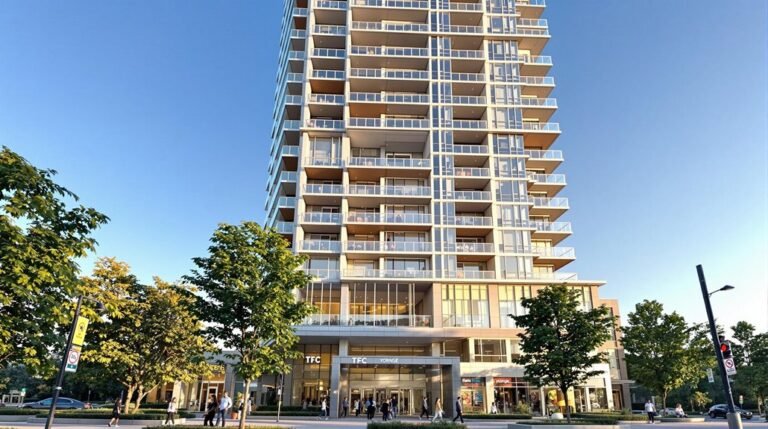Downtown Toronto’s rental market is experiencing some interesting shifts. I’ve noticed that while the vacancy rate is at a tight 1.5%, there’s been a 43% increase in new condo listings. Surprisingly, average rents have dipped slightly: one-bedrooms are now $2,452 (-3.1%) and two-bedrooms $3,178 (-1.9%). But don’t be fooled – demand is still hot! The absorption rate is a whopping 71%, meaning units are being snapped up quickly. With 880,000 new residents since 2013 and a projected need for 312,000 more rental units, investment opportunities are knocking. If you’re curious about which neighborhoods are sizzling or why some folks are choosing to rent over buy, there’s more to uncover.
Key Takeaways
- Rental prices have decreased slightly, with one-bedroom condos averaging $2,452 and two-bedrooms at $3,178.
- New condo listings increased by 43% year-over-year, contributing to a low 1.5% vacancy rate.
- Strong demand is driven by population growth, with 880,000 new residents in the Greater Toronto Area from 2013-2022.
- Investment opportunities exist in affordable units, properties near transit, student housing, and mixed-use developments.
Current Market Overview
Amid a surge in condo rental listings, Downtown Toronto’s rental market remains tight, with a complex interplay of increased supply and persistent demand shaping the current landscape. I’ve been keeping a close eye on the market, and let me tell you, it’s like watching a high-stakes game of Jenga – every new piece added to the tower could potentially shake things up!
Here’s what I’ve observed:
- A whopping 43% year-over-year increase in new condo listings in Q1 2024
- A stubbornly low vacancy rate of 1.5%
- A slight dip in average one-bedroom condo rents to $2,452 (down 3.1% from last year)
[Insert simple bar graph showing the increase in listings and decrease in rent prices]
Now, you might be thinking, “More listings and lower rents? That’s great news!” And you’re not wrong – it’s a bit of a breather for renters who’ve been feeling the squeeze. But don’t pop the champagne just yet! The market’s still tighter than skinny jeans after Thanksgiving dinner.
The improved absorption rate tells us that despite the influx of new listings, demand is still robust. It’s like Toronto’s rental market is a giant sponge, soaking up new units almost as quickly as they appear.
What does this mean for renters and investors? Well, it’s a mixed bag. Renters might find a bit more choice and slightly better prices, but competition remains fierce. For investors, it’s a signal that the market’s still hot, but they’ll need to be savvy to stand out in an increasingly crowded field.
Rental Price Trends
Let’s zoom in on the rental price trends that are shaping Downtown Toronto’s market landscape. I’ve crunched the numbers, and they’re painting an interesting picture.
First off, we’re seeing a bit of a breather in rental prices. One-bedroom condos in Downtown Toronto are now averaging $2,452 per month, which is a 3.1% drop from last year. It’s like the market’s taking a quick pit stop after a long race! Two-bedroom units are following suit, with average rents dipping 1.9% to $3,178.
Now, you might be wondering, “What’s behind this sudden change?” Well, it’s all about supply and demand, folks. We’ve seen a whopping 51.3% increase in condo rental listings compared to last year. More options for renters means less pressure on prices – it’s like having more slices of pizza at a party; everyone gets a fair share!
But don’t get too excited just yet. While these trends suggest a short-term improvement in affordability, the market’s still tighter than a drum. The national rental vacancy rate is at a low 1.5%, which we haven’t seen since 1988. That’s like trying to find a needle in a haystack!
Here’s what it all means:
- Slight price relief for renters
- More choices in the rental market
Looking ahead, keeping rental prices in check will depend on:
- Continued influx of new rental units
- Maintaining increased inventory levels
Supply and Demand Dynamics
I’m diving into the push and pull of supply and demand that’s shaping Downtown Toronto‘s rental landscape. It’s like watching a game of tug-of-war, with some surprising twists!
On one side, we’ve got a surge in rental supply. Downtown Toronto is seeing a whopping 43% increase in new condo listings compared to last year. That’s a lot of fresh options for renters! 🏙️
But here’s the kicker: despite all these new listings, the national rental vacancy rate is still super tight at just 1.5%. It’s like trying to squeeze into skinny jeans after a big meal – not much wiggle room!
So, what’s going on? Well, it’s a bit of a mixed bag:
- More choices: The flood of new listings is giving renters more options to pick from.
- Slight price relief: Average rent for one-bedroom condos has dipped to $2,452, offering a tiny breather for wallets.
The absorption rate, which measures how quickly rentals are snatched up, sits at 71%. That’s like a moderately popular item on Black Friday – moving, but not flying off the shelves.
In a nutshell, we’re seeing more supply, but demand is still hanging tough. It’s a delicate balance, and one that savvy renters and investors alike should keep an eye on. As the market continues to evolve, staying informed is key to making smart decisions in this dynamic rental landscape.
Investment Opportunities
Downtown Toronto’s rental market is a goldmine of investment opportunities, with soaring demand and promising long-term growth prospects. As an investor, I’m excited by the 25.2% increase in condo rentals we’ve seen in Q2 2024. This surge in demand is like a feeding frenzy for savvy property investors!
But wait, there’s more good news: the average rent for one-bedroom condos has dipped to $2,452. This slight decrease is like a magnet for potential tenants, which means we can attract a larger pool of renters. It’s a win-win situation – tenants get a bit of relief, and we get a wider selection of potential occupants.
Looking ahead, the Greater Toronto Area needs a whopping 312,000 new rental units over the next decade. That’s like building a small city! This presents a golden opportunity for developers and investors to jump into the market. With a vacancy rate of just 1.5%, it’s clear that demand isn’t slowing down anytime soon.
So, where should we focus our investments? Here are some key areas to consider:
- Affordable rental units
- Properties near public transit
- Student housing near universities
Neighborhood-Specific Insights
While we’ve explored the broader investment landscape, it’s time to zoom in on the unique characteristics of Downtown Toronto‘s diverse neighborhoods. As we delve into the specifics, we’ll find that each area has its own flavor and rental market dynamics.
Let’s start with the Entertainment District, known for its vibrant nightlife and proximity to theaters. Here, I’ve noticed that one-bedroom condos are particularly popular among young professionals and artists. The recent 3.1% decrease in average rent for one-bedrooms to $2,452 might make this area more attractive to those looking to be in the heart of the action.
Moving east to the St. Lawrence Market area, we see a different story. This historic neighborhood tends to appeal more to families and established professionals. The 1.9% drop in two-bedroom condo rents to $3,178 could be a game-changer for those seeking more space in this charming district.
In the Financial District, the rental market is as fast-paced as the stock exchange. With the lowest vacancy rate since 1988 at 1.5%, competition for units here is fierce. It’s like trying to grab the last slice of pizza at a party – you’ve got to be quick!
Here’s a quick rundown of neighborhood highlights:
- Entertainment District: Hotspot for one-bedrooms
- St. Lawrence Market: Family-friendly with more affordable two-bedrooms
As we can see, Downtown Toronto’s rental market is like a patchwork quilt – diverse, colorful, and full of interesting patterns. Each neighborhood offers its own unique opportunities for both renters and investors.
Economic Factors Influencing Rentals
Let’s dive into the economic whirlpool that’s shaping Downtown Toronto’s rental landscape. It’s a bit like watching a game of musical chairs, but instead of music stopping, it’s the housing market that’s calling the shots.
First up, we’ve got a vacancy rate that’s tighter than a drum at 1.5% – the lowest since 1988! This means finding a rental is about as easy as spotting a unicorn in the city. Why? Well, it’s a classic case of supply and demand:
- Demand is skyrocketing due to:
- Record population growth (880,000 new residents from 2013 to 2022!)
- People choosing to rent instead of buy (thanks to high mortgage payments)
- Migrants flocking to urban centers like Toronto
Now, here’s a silver lining for renters: the average rent for a one-bedroom condo in Downtown Toronto has dipped to $2,452 in Q2 2024. It’s not exactly pocket change, but it’s a small victory in this economic tug-of-war.
Employment rates and interprovincial migration are also stirring the pot. Picture Toronto as a giant magnet, attracting job seekers and out-of-province folks looking for new opportunities. This influx keeps the rental market buzzing like a beehive.
In a nutshell, Toronto’s rental market is feeling the heat from various economic factors. It’s a complex dance of population growth, housing affordability, and migration patterns. As we navigate this rental rollercoaster, keep an eye on these trends – they’re the key to understanding where the market’s heading.
Future Market Projections
In light of recent market trends, I’m peering into my crystal ball to forecast what’s on the horizon for Downtown Toronto’s rental scene. Despite a bit of a wobble in early 2024, I’m seeing strong demand continuing to shape the market. Why? Well, it’s all about people power – population growth and folks moving in from other provinces are keeping things hopping.
Now, here’s where it gets interesting:
- Supply is key: We need more rental units to keep prices in check
- Vacancy rates are tight: At 1.5%, finding a place might feel like a game of musical chairs
Looking ahead, I’m seeing a bit of a tug-of-war. On one side, we’ve got increasing demand pulling prices up. On the other, new listings are trying to keep things balanced. But here’s the kicker – we need a whopping 312,000 new rental units in the Greater Toronto Area over the next decade. That’s like building a small city!
For investors and developers, this spells opportunity with a capital ‘O‘. Imagine being the one to provide those much-needed homes. It’s like being the person who brings snacks to a hungry crowd – you’ll be everyone’s favorite!
Conclusion
As I wrap up this deep dive into Toronto’s rental market, I’m struck by the ever-changing landscape. Like a bustling beehive, the city’s rental scene is constantly buzzing with activity. While challenges persist, opportunities abound for savvy investors and renters alike. With careful research and a keen eye on market trends, navigating this complex ecosystem becomes more manageable. As we look to the future, Toronto’s rental market promises to remain dynamic, reflecting the city’s growth and evolution.


















